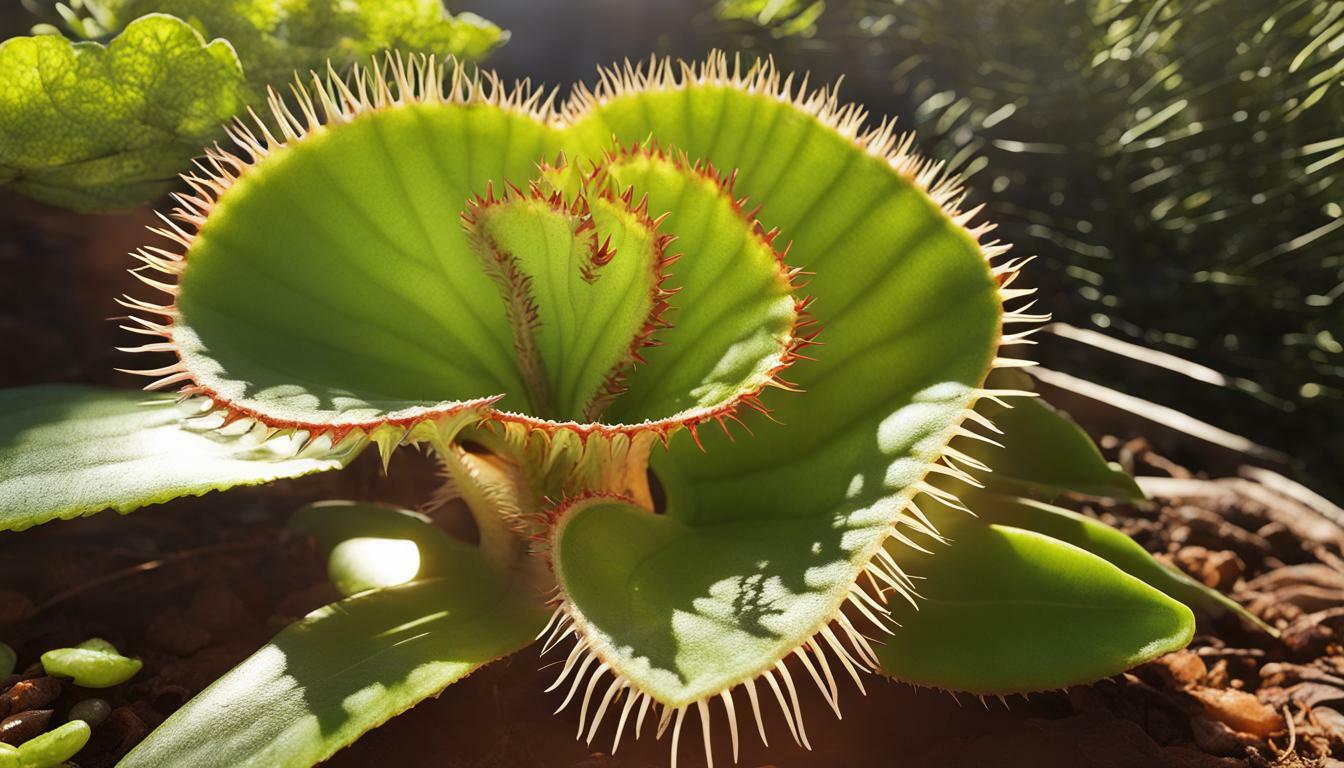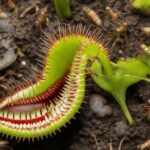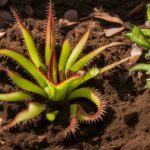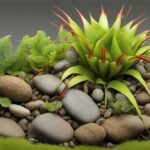If you’re planning to grow Venus flytraps, you might be wondering how much sunlight they need. These carnivorous plants are native to boggy areas with lots of sunlight. Proper light exposure is crucial to their growth and overall health.
Read on to find out more about Venus flytrap sunlight requirements and how you can create the best conditions for them.
Key Takeaways:
- Venus flytraps need adequate sunlight to grow and thrive.
- Understanding their specific light requirements is important for their long-term health and survival.
Understanding Venus Flytrap’s Light Requirements
As a carnivorous plant, Venus flytraps have a unique set of light requirements that differ from other plants. Optimal sunlight for Venus flytraps is crucial for their growth and survival.
Venus flytraps require moderate to bright light for at least 12 hours a day. This includes both natural and artificial light sources. It is important to note that direct sunlight can be harmful to Venus flytraps, as it can cause leaf burn. Therefore, it is recommended to provide indirect sunlight or to filter direct sunlight using a sheer curtain or shade cloth.
When it comes to light exposure, Venus flytraps require a balance between light and darkness. While they need a certain amount of light to digest insects and perform photosynthesis, they also require a period of darkness to rest and recover. Experts recommend providing a 16-hour cycle of light and darkness, mimicking the plant’s natural environment.
Factors Affecting Venus Flytrap’s Light Intensity
The light intensity received by Venus flytraps is influenced by several factors. In their native habitat, Venus flytraps grow in acidic soil on the edges of marshes and bogs, where they receive moderate to bright sunlight. However, during the winter months, the light intensity decreases, and the plants enter a period of dormancy.
The positioning of Venus flytraps in relation to light sources affects their light exposure as well. Placing them near a south-facing window or under artificial grow lights can provide them with the optimal amount of light they need. However, it is important to avoid placing them in direct sunlight or near heat sources, as it can damage or dry out the leaves.
In summary, understanding the optimal sunlight for Venus flytraps and their light exposure is crucial for their growth and survival. Creating suitable light conditions for them by considering the factors that affect light intensity, implementing the recommended light duration, and providing indirect light sources will ensure their long-term health.
Factors Affecting Venus Flytrap’s Light Intensity
Venus flytraps require intense light to photosynthesize and produce energy. However, the amount of light they receive can significantly affect their growth and development. Several factors influence the light intensity that Venus flytraps receive in their natural habitat, and replicating these conditions is critical for their optimal health and survival.
The primary factor that affects the light intensity received by Venus flytraps is their native habitat. Venus flytraps naturally grow in wetlands with low soil fertility and acidic soil. These areas receive intense but filtered sunlight due to the presence of tall trees and other vegetation. The shade provided by these trees protects the plants from direct sunlight, which can scorch their leaves.
The season also impacts the light intensity received by Venus flytraps. During the summer months, when the sun is at its highest, Venus flytraps may require more shade than in the cooler months. In winter, when the sun is low on the horizon, Venus flytraps may require more direct sunlight to maintain healthy growth.
The positioning of Venus flytraps in relation to light sources is another essential factor affecting the light intensity they receive. Venus flytraps placed too close to light sources, such as grow lights or windows, may receive excessive light that can damage their leaves. In contrast, those placed too far from light sources may receive insufficient light, affecting their overall growth.
Therefore, when creating suitable light conditions for Venus flytraps, it is crucial to consider their native habitat, season, and positioning in relation to light sources. By replicating these conditions, you can ensure that your Venus flytrap receives the appropriate amount of light intensity required for healthy growth.
Recommended Light Duration for Venus Flytraps
It’s important to keep in mind that Venus flytraps require a balance of light and darkness in order to properly simulate their natural environment. As a rule of thumb, a Venus flytrap should receive at least 12 hours of light per day, followed by 12 hours of darkness.
While it may be tempting to provide your flytrap with constant light, this can actually harm its growth and lead to premature death. Venus flytraps require a period of darkness to rest and conserve energy, just like any other plant.
In addition to providing a balance of light and darkness, it’s also important to consider the quality of light that your Venus flytrap receives. Natural light sources such as sunlight and window light can be an excellent source of light for your plant, but be sure to avoid placing it in direct sunlight for extended periods of time, as this can cause damage to the leaves.
If you decide to use artificial light, be sure to choose a grow light that emits the proper wavelength of light for Venus flytraps. A full spectrum LED grow light is a great option, as it mimics natural sunlight and provides the necessary spectrum of light for your flytrap’s growth.
Creating Suitable Light Conditions for Venus Flytraps
Providing proper light conditions is crucial for the healthy growth of your Venus flytrap. The best sunlight for Venus flytraps is bright but not direct, as they are adapted to thrive in filtered light conditions in their native habitat. Here are some tips on creating optimal light conditions:
- Position your Venus flytrap near a window that receives bright, filtered sunlight for at least four hours a day. Avoid direct sunlight, which can scorch the leaves.
- Use artificial, full-spectrum grow lights to supplement natural light during the winter months or if you don’t have access to a bright window. Place the lights close enough to provide the necessary intensity (2000-3000 lux) but not so close as to overheat the plant.
- Avoid fluorescent or incandescent bulbs, as they do not provide the required light spectrum for healthy growth.
- Provide a day-to-night cycle by turning off the lights for at least 8 hours each day to simulate the Venus flytrap’s natural environment. This balance between light and darkness is essential for their survival.
- Monitor your Venus flytrap regularly to ensure that it’s not receiving too much or too little light. Signs of excessive light exposure include blackened or withered leaves, while inadequate light can cause stunted growth and a lack of color.
By following these simple guidelines, your Venus flytrap can thrive in its new environment with the right amount of natural light and supplemental artificial light.
Conclusion
In conclusion, proper lighting conditions are crucial to the health and survival of Venus flytraps. As a carnivorous plant, these unique species require specific amounts of sunlight and darkness to thrive. Failure to provide the right light conditions can lead to stunted growth and even death. To ensure your Venus flytrap receives optimal light exposure, it is important to understand their specific light requirements. This includes providing the ideal light intensity, duration, and natural light sources. Factors such as habitat, season, and positioning in relation to light sources also play a significant role in their overall health. Creating the right light conditions for your Venus flytrap can be achieved through a combination of natural light sources and artificial grow lights. Positioning your plant near a window that receives indirect but bright light, or providing artificial lighting with a timer, can simulate their natural environment and promote healthy growth. By meeting the specific light requirements of your Venus flytrap, you can ensure they thrive for years to come. Remember, proper lighting conditions are essential to their overall health and survival.Does the Amount of Sunlight a Venus Flytrap Receives Affect How Often It Needs to Eat?
The venus flytrap feeding frequency is influenced by the amount of sunlight it receives. These fascinating plants rely on photosynthesis to produce energy, and sufficient sunlight enables them to generate the necessary nutrients. Consequently, a Venus flytrap that receives ample sunlight may not require frequent feeding, as it can obtain energy through photosynthesis. Conversely, a plant that receives limited sunlight might need to eat more frequently to compensate for the reduced photosynthetic process.
FAQ
Q: How much sunlight does a Venus flytrap need?
A: Venus flytraps require about 6-8 hours of direct sunlight daily to thrive.
Q: What are the light requirements for Venus flytraps?
A: Venus flytraps need optimal sunlight exposure to grow properly. This includes the right intensity and duration of light.
Q: What factors affect the light intensity for Venus flytraps?
A: The light intensity received by Venus flytraps can be influenced by factors such as their native habitat, season, and positioning in relation to light sources.
Q: How long should Venus flytraps be exposed to light?
A: Venus flytraps should be exposed to light for about 6-8 hours daily to mimic their natural environment and promote healthy growth.
Q: How can suitable light conditions be created for Venus flytraps?
A: To create suitable light conditions for Venus flytraps, you can use grow lights, position them near windows for natural light, and avoid excessive direct sunlight.
Q: Why is adequate sunlight important for Venus flytrap’s growth?
A: Adequate sunlight is crucial for Venus flytrap’s growth as it provides the energy needed for photosynthesis and overall plant health.
Q: What is the recommended light duration for Venus flytraps?
A: Venus flytraps should be exposed to light for approximately 6-8 hours per day to ensure their proper development and well-being.











